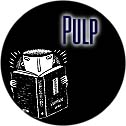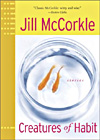
Comment
on this story
|
 |

New collections add zing to summer reading
by Julia Watts
During most of the year, my favorite form of fiction is the big, fat novel. In the fall, winter, or spring, you can hand me a doorstop-sized intergenerational saga or an encyclopedic account of a fictional character's entire life, and I'll be up all night turning pages. But something about the summer months seems to shorten my attention span. When the season for poolside reading rolls around, I like my fiction to be either light or short, and since even I can only gobble down so many light and fluffy "beach books," sometimes a collection of short stories can be a good match for the short attention span of summer.
Jill McCorkle's Creatures of Habit (Algonquin, $12.95) is a short story collection based on an intriguing concept. Each of the 12 stories is named for an animal ("Chickens," "Toads," "Hominids," etc.). While none of the stories are primarily about animals, the animals in the titles have qualities that contribute to the stories' themes. For example, the protagonist of "Chickens," a new bride who is certain she has married the wrong man, remembers the cruelty of her so-called  friends following her break-up with the man she really loved: "Was it like that story her father used to tell about chickens in the barnyard, how they can all be living in harmony and then if one starts bleeding they all rush in and peck it to death?" friends following her break-up with the man she really loved: "Was it like that story her father used to tell about chickens in the barnyard, how they can all be living in harmony and then if one starts bleeding they all rush in and peck it to death?"
The collection's structure reveals a theme that goes hand-in-hand with the animal theme. The first short stories focus on children. The next stories focus on younger adults; the following stories on adults in middle life, then on the elderly, and finally on the dying. The structure of Creatures of Habit speaks of the most inarguable fact of life: that all creatures are moving toward death.
Despite the dark theme, many of McCorkle's stories brim with humor. In "Turtles," the elderly Carly muses on the differences between the two wings of the nursing home where she lives: "If you are ambulatory...you can stay on the east hall even if you can't remember who you are. The way to remember which wing is which is easy enough. East means you can still rise. West means you are left setting." "Snakes" is a hilarious short story with a great first line: "I was going to get my tubes tied but I decided to go to the movies instead."
I have always enjoyed Jill McCorkle's depictions of contemporary Southern life, and Creatures of Habit is a nice addition to her body of work. Strangely, the first story ("Billy Goats") and the last story ("Fish") struck me as the least effective pieces of the collection, perhaps because they serve the purpose of establishing and wrapping up the book's theme and therefore lack strength as free-standing stories. The 10 stories sandwiched in between the first and the last, though, are simultaneously funny, sad and thought-provoking.
Irene Zabytko's When Luba Leaves Home (Algonquin, $19.95) is a collection of related short stories narrated by Luba, a Ukrainian-American college student in Chicago's Ukrainian Wheat Street neighborhood in the 1960s. Luba struggles with her identity. Is she Luba, the dutiful Ukrainian daughter, or Linda (the name she goes by at college), the white lipstick-wearing, Plymouth Valiant-driving free thinker?
Despite Luba's quest for her identity, many of the stories focus not on her, but on the "Ukies"  around her: the rabid Ukrainian nationalist landlady, who finds an unlikely romance with a boarder in "Pani Ryhotka in Love;" the friend of Luba's who tries to help a now-homeless woman she recognizes from her time in the DP ("Displaced Person") Camps in "Obligation;" the much-lauded widow of a famous Ukrainian poet, who proves that she's not a heroine, only a human. The best of Zabytko's stories, such as "Saint Sonya" and "Pani Ryhotka in Love," use the likable character of Luba as the lens through whom we meet intriguing characters. around her: the rabid Ukrainian nationalist landlady, who finds an unlikely romance with a boarder in "Pani Ryhotka in Love;" the friend of Luba's who tries to help a now-homeless woman she recognizes from her time in the DP ("Displaced Person") Camps in "Obligation;" the much-lauded widow of a famous Ukrainian poet, who proves that she's not a heroine, only a human. The best of Zabytko's stories, such as "Saint Sonya" and "Pani Ryhotka in Love," use the likable character of Luba as the lens through whom we meet intriguing characters.
Sometimes, though, the use of Luba as a lens can wear a bit thin. Perhaps because of the title, I expected the stories to focus on Luba, and I often found myself wanting to hear more of her thoughts and feelings, for her to spend more time as a character instead of a camera.
Also, Zabyktko's prose could use a bit more zip in spots. In "Steve's Bar," a riot at Steve's is passively described as "the bar being demolished by about thirty furious émigrés." In "The Celebrity," when describing the merry widow of the Ukrainian poet's entrance into a dance club, she simply states, "The celebrity was excited as she entered the club." While Zabytko's reluctance to write purple prose is commendable, her descriptions could be livened up a bit.
Despite these criticisms, however, Zabytko does give us an interesting glimpse at some unique characters in a unique culture. I hope that next time she'll let us have a longer, harder look.

July 24, 2003 * Vol. 13, No. 30
© 2003 Metro Pulse
|